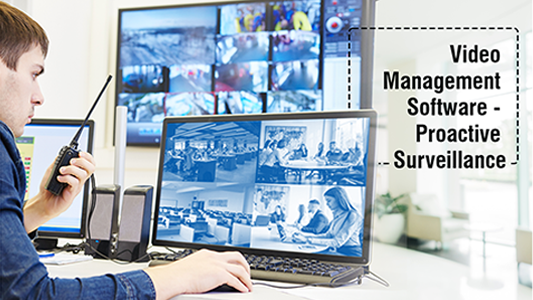The Indian Video surveillance market continues to grow at a Compounded Annual Growth Rate (CAGR) of 13% from 2021 to 2026. The industry’s market size was USD 1.5 billion in 2020. Several government initiatives like the Safe City Projects have significantly boosted the industry.
A comprehensive surveillance system comprises Cameras, which capture video footage and relay it to the recording devices for investigation purposes or a monitor for live viewing. Additionally, Video Management Software controls and manages the footage captured by the cameras and allows users to view, search and analyze the footage.
In this post, we will discuss in detail the video management system and its role in building a proactive video surveillance solution.
Key Roles of Video Management Software:
- Recording and Storage: Just having an infrastructure of CCTV cameras installed at your premises is not enough. It is essential to record and store video footage captured by the cameras. Video Management Software records and stores videos in various formats for flexible storage options.
- Streaming and Playback: VMS allows users to view the camera feeds in real-time and play back the recorded footage. It enables users to view multiple cameras simultaneously and manage the cameras from a remote location. The software provisions prompt action and reduce human lapses.
- Centralized Video Surveillance: Advanced Video Management Software aids in managing Cameras and other peripheral security devices from a remote location. A few solution providers allow Admin to assign user-based roles and rights for enhanced decision-making and quick response time.
- Proactive Video Surveillance: VMS can be configured to send alarms and notifications in case of the occurrence of suspicious activity. This helps in automating the entire process and eliminates the chances of human errors. Quick decision-making allows for averting untoward incidences.
- Search and Retrieval: Once the videos have been recorded from multiple cameras, the user must be able to easily search through multiple videos using advanced search capabilities like time-based search and time-lapse videos.
- Analytics: VMS can provide advanced analytics like facial recognition, auto-tracking, license plate recognition, and more. It also provides detailed reports and analytics for the users to analyze their existing security system needs. This helps with better decision-making.
These features make a Video Management System a critical component of video surveillance and help users effectively manage and utilize the footage captured by the cameras.
What features to look for in a Video Management System?
- Integrates all your security devices: There are many security devices that may be installed in your premises like the fire alarm system, sensors, cameras, and more, a good VMS will integrate all security devices in your premises.
- Integration with other Systems: A good Video Management System should be able to integrate with other security systems like the ERP, POS, Access Control, weighbridge, and more for advanced security solutions.
- User-Based Roles and Rights: In large organizations, security cannot be the responsibility of a single person to address this it is essential for the VMS to have the capability to assign different roles and rights to different people in the organization.
- Centralized Video Surveillance: For organizations with multi-site offices, the VMS should be able to integrate all locations and provide centralized surveillance. This makes it easy to monitor all locations in real time and hastens response time.
- Mobile Access: Video Surveillance on the go is the need of the hour. VMS allows users to monitor their premises from anywhere, the user also gets alerts and notifications when any suspicious activity occurs.
- User-friendly Interface: Video Management Softwarefrom Matrix Comsec comes with a hierarchical E-Map monitoring for easy navigation between different floors and offices at different locations.
- Redundancy and Failover: To ensure that there is no loss of data due to various reasons it is necessary that the VMS is designed to have redundancy and failover features. This enables the system to function seamlessly.
VMS is critical in managing and analyzing video footage captured by surveillance cameras. It enables the recording and storage of videos, streaming and playback, centralized surveillance, proactive surveillance, search and retrieval, and analytics. Some essential features to look for in a VMS include integration with all security devices, integration with other systems, user-based roles and rights, centralized surveillance, mobile access, a user-friendly interface, and redundancy and failover features. The use of VMS has become increasingly important as the Indian video surveillance market continues to grow, and with government initiatives like Safe City Projects with VMS businesses can create a proactive video surveillance solution and improve their security.
For More Visit : https://bit.ly/3Ao3vYF












